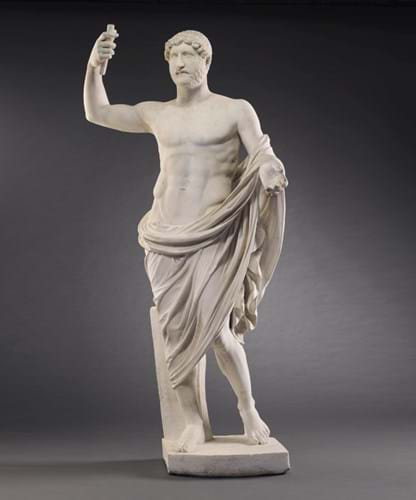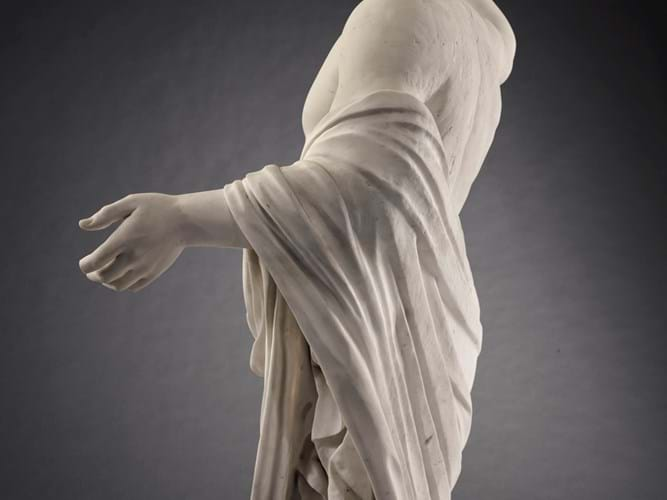
Dating from the 2nd century AD, the 6ft 10in (2.08m) high marble statue known as ‘The Cobham Hall Hadrian’ is expected to fetch in the region of $6m when it is offered at Christie’s New York on October 29.
It is the first full-length Classical statue of a Roman emperor to appear at auction since the work was bought by Levett for $902,500 (£609,840) including premium at Christie’s New York in December 2008.
The statue was sculpted during the reign of the Emperor Hadrian (117-138 AD). As was often the case with antiquities collected during the Renaissance through to the 18th century, missing appendages were restored in order to present a complete statue, which was the preference of Grand Tour collectors.
Workshops active in Rome specialised in making replacement limbs to complete fragmentary statues, as seen here, where the feet, the right arm and the left hand were all added.
In terms of the central features of the Cobham Hall Hadrian, the head and torso are both ancient, dating to the 2nd century AD, but sculpted from different marbles. It is impossible to know if the two parts were original to each other already during Hadrian’s reign or combined during the Grand Tour restoration program.
The head features extraordinary physiognomic detail which includes a diagonal crease in his preserved left earlobe – a symptom of the subject’s coronary artery disease. The body stands in ‘chiastic’ pose with Hadrian’s weight on his right leg, his left leg bent at the knee and drawn back and his right arm raised – a stance that recalls the work of the earlier 5th century BC Greek sculptor Polykleitos.

A detail of the Roman statue of the Emperor Hadrian, estimated in the region of $6m at Christie’s New York. Image: Christie's Images Ltd 2019.
Levett has amassed one of the world’s most important private collections of antiquities and in 2011 opened his own museum, the Musée d’Art Classique de Mougins, in southern France to house part of it, including this statue.
The Cobham Hall Hadrian is now being sold to benefit the museum.
Christie’s international department head of antiquities G Max Bernheimer said: “This masterpiece has incomparable provenance and represents an opportunity to not only own an important work of art but also to help fund the future of a truly remarkable institution.”
Earlier provenance
The work holds a distinguished provenance, being formerly in the Villa Montalto-Negroni-Massimi in Rome. It is mentioned in a letter from 1787 preserved in the British Museum between the antiquarian Thomas Jenkins and his client, the collector Charles Townley, where Jenkins lists the sculptures from the Villa Montalto that were available for acquisition.
A second letter from 1790 informs that the Hadrian had been acquired in the 18th century by John Bligh, 4th Earl of Darnley (1767-1833) for his home, Cobham Hall in Kent.
It remained there until it was sold by the Darnley estate at Sotheby’s in London in 1957, where it was acquired by the New Orleans dealer J Wilson Raker, who sold it to Iberiabank.
Hadrian's Iberian ancestry was the inspiration for the bank's acquisition and the statue was placed on a pedestal outside the St Peter branch of the bank in the town of New Iberia, Louisiana until 1980, where it was covered by a domed glass enclosure.

A detail of the Roman statue of the Emperor Hadrian, estimated in the region of $6m at Christie’s New York. Image: Christie's Images Ltd 2019.
Imperial subject
Hadrian is perhaps best known in the UK for building Hadrian's Wall, the Roman frontier fortification between northern England and Scotland.
Of Spanish descent, he was adopted by the Emperor Trajan as his son and heir.
During his 21-year reign, as well as solidifying the empire’s borders, he also initiated an unparalleled building programme throughout the empire. In Rome, he built the Pantheon in the Campus Martius, the Temple of Venus in the Forum and his own Mausoleum, now known as the Castel Sant' Angelo. He also famously constructed a sumptuous villa at Trivoli.





